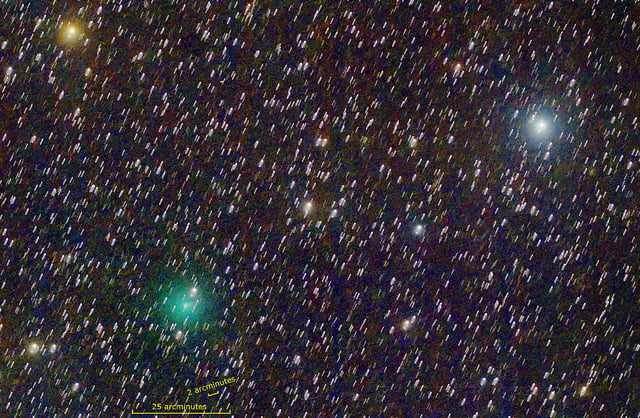One. More. Comet. Though the next great 'Comet of the Century' has yet to make its appearance in 2018, we've had a steady stream of binocular comets this year, including Comets
C/2017 S3 PanSTARRS
,
38P Stephan-Oterma
, and
21P Giacobini-Zinner
.
Now, the calendar year may have saved the best for last, as periodic Comet 46P Wirtanen takes center stage.
U.S. astronomer Carl Wirtanen first spied the 46
th
periodic comet in the catalog on the night of January 17
th
, 1948 while carrying out a stellar proper motion survey from the Lick Observatory. Wirtanen went on to discover four more comets.
[caption id="attachment_140407" align="alignnone" width="580"]
Comet 46P Wirtanen's orbit. Credit: NASA/JPL[/caption]
Though it took over a year to initially construct the orbit of the comet, it was soon realized that its orbital period is short indeed: 46P Wirtanen takes just 5.4 years to go once around the Sun, ranging from an aphelion of 5.1 Astronomical Units (AU ) inside of Jupiter's orbit to a perihelion of 1.06 AU, just exterior of Earth's path around the Sun. The comet's orbit is also inclined 11.7 degrees relative to the ecliptic.
Comet 46P Wirtanen
has actually had its orbit modified slightly by successive passes near
Jupiter in 1972 and 1984
.
Fun Fact: Comet 46P Wirtanen was once on the shortlist for potential destinations for the European Space Agency's Rosetta mission, which ultimately headed to Comet 67P Churyumov-Gerasimenko .
The 2018 pass of Comet 46P Wirtanen is the closest one to the Earth since its discovery 70 years ago, and the closest for the 21
st
century. In fact, this is the 20
th
closest known cometary passage near Earth... period. But as we'll show you in a second, this anticipated close approach is favorable for observation... with a few caveats.
In 2018, Comet 46P Wirtanen starts the month of November at a respectable +8th magnitude, racing up through the southern hemisphere sky from the constellation Fornax the Furnace into Cetus the Whale. The action heats up in December, as the comet gains steam and moves at 4 degrees per day (that's the equivalent of the diameter of a Full Moon every three hours!) on closest approach in mid-December, racing through the constellations of Eridanus, Taurus and Auriga as it vaults up over the ecliptic plane and into the northern hemisphere sky. From latitude 30 degrees north, this places Comet 46P Wirtanen high to the south just before midnight in December, starting the month at an elevation of 40 degrees above the horizon, crossing through the midnight zenith on December 18th, and ringing in New Year 2019 60 degrees above the
northern
horizon at 2 AM local.
Not bad for observing. There is a worldwide campaign afoot to observe Comet 46P during its 2018 apparition, including this one courtesy of the
University of Maryland
.
Here are some key observational dates with destiny for Comet 46P Wirtanen to watch for in the coming months:
November
1-Breaks +10
th
magnitude.
18-Passes near (unless otherwise stated, we're denoting 'near' passes for this ephemeris as less than one degree) the 5
th
magnitude star Nu Fornacis.
27-Crosses into the constellation Cetus.
[caption id="attachment_140408" align="alignnone" width="580"]
The celestial path of Comet Wirtanen through December. Credit: Starry Night.[/caption]
December
5-Crosses into the constellation Eridanus.
6- Passes near the +3.8 magnitude star Azha.
9-Crosses back into the constellation Cetus.
10-Crosses the celestial equator northward.
12-Crosses into the the astronomical constellation Taurus.
13-Reaches perihelion at 1.048 AU from the Sun.
15-Crosses the ecliptic plane northward.
16-Photo-op: passes two degrees from the Pleiades open cluster (M45).
16-Passes closest to the Earth, at 0.077 AU (7.16 million miles) distant.
19- Crosses into Perseus.
21-Crosses into Auriga.
22-Crosses the galactic plane northward.
22-Passes near the bright star Capella.
28-Crosses into the Lynx.
[caption id="attachment_140409" align="alignnone" width="580"]
The December passage of Comet 46P Wirtanen near M45. Credit: Starry Night.[/caption]
January
10-Reaches a maximum northern declination of +59 degrees.
12-Crosses into Ursa Major.
[caption id="attachment_140410" align="alignnone" width="580"]
The projected light curve for Comet 46P.
- Credit
-
Seiichi Yoshida's Weekly Information on Bright Comets.[/caption]
February
11-Passes near the +3 magnitude star Theta Ursa Majoris.
Comet 46P Wirtanen could be a tricky one. Its close (7.16 million mile) passage only 29 times more distant than the Moon bodes well for a maximum +3 magnitude: possibly naked eye. Keep in mind, however, all of that brightness will get smeared out over an extended coma, another consequence of its close approach. Be sure to seek out dark skies in your 2018 quest for Comet 46P Wirtanen.
Good luck, and clear skies!
Read all about observing comets in our new book,
The Universe Today Ultimate Guide to Viewing the Cosmos:
On
sale now
.
 Universe Today
Universe Today
